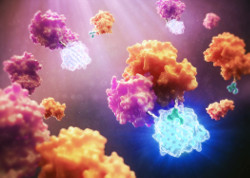 Back in 2015 the Ice Bucket Challenge brought Amyotrophic Lateral Sclerosis (ALS) to public attention, initiating worldwide pleas for more funding of research toward a cure for this fatal disease, which is characterized by progressive degeneration of motor neurons. In spite of many efforts over the last few decades, the precise cause of ALS is still unknown.
Back in 2015 the Ice Bucket Challenge brought Amyotrophic Lateral Sclerosis (ALS) to public attention, initiating worldwide pleas for more funding of research toward a cure for this fatal disease, which is characterized by progressive degeneration of motor neurons. In spite of many efforts over the last few decades, the precise cause of ALS is still unknown.
The complexity of the problem of ALS pathogenesis is highlighted in the review “Decoding ALS: from genes to mechanism” published in Nature in November 2016. The review highlights a long list of genetic factors implicated in ALS, grouping them into genes affecting protein quality control, RNA stability/function, and the cytoskeletal structure of neuronal cells.
Mutations in the antioxidant enzyme superoxide dismutase (SOD1) were the first to be associated with ALS. According to the review, more than 170 SOD1 mutations causing ALS have since been identified. Many of these mutations are thought to result in misfolding of SOD1, contributing to toxicity when the misfolded protein accumulates within the cell.
A paper by Oh-hashi et al., published in Cell Biochemistry and Function in October 2016 used the NanoBiT protein complementation assay to investigate the effect of two common ALS-associated SOD1 mutations on dimerization of the SOD1 protein. The NanoBiT protein interaction assay uses two complementary subunits of NanoLuc luciferase—termed Large Bit and Small Bit—to create a luminescent, live-cell protein interaction assay. When two proteins tagged with Large Bit and Small Bit interact with each other the NanoLuc fragments are brought together, generating a bright luminescent signal in live-cell assays.
In the Oh-hashi study, fusion proteins of large and small NanoBiT fragments were generated for wildtype and mutant forms of SOD1. Upon transfection into COS7 cells, a luminescent signal (indicating dimer formation) was observed only with the wildtype protein. Mutant forms of the protein did not generate luminescence, indicating an inability to form dimers. The authors report that this is consistent with other studies suggesting that mutant forms of SOD have decreased conformational stability and favor the monomeric form, which is prone to misfolding and associated with neurotoxicity.
The authors also used the NanoBiT assay to investigate whether a second ALS-associated protein–the Tar-binding protein hTDP43–formed homodimers or interacted with SOD1, and found neither to be the case. They also used the assay to study the effect of a zinc chelator on dimerization by wildtype SOD1. They concluded that the NanoBiT assay gave sensitive results and was a convenient method for use in developing and testing agents for the modulation of SOD1 conformation.
The Oh-hashi paper happened to come to my attention because of the technology used. It is just one small snapshot from a vast body of ALS research that has contributed much over the last 20 years. The long list of genetic factors implicated in the development of ALS and reviewed in the Nature paper are a strong reason for the hope expressed in that review:
Extraordinary progress in understanding the biology of ALS provides new reasons for optimism that meaningful therapies will be identified.
Here’s to hope that the dedication of all the scientists who continue to contribute to this field will be rewarded with adequate funding, continued discovery and the eventual development of therapies that consign this terrible disease to history.
Here are the papers:
- Taylor, J.P. et al (2016) Decoding ALS: from genes to mechanism. Nature, 539, 197–206.
- Oh-hashi, K. et al (2016) SOD1 dimerization monitoring using a novel split NanoLuc, NanoBit. Cell Biochem Funct. 34(7), 497-504.
Learn more about NanoBiT Technology here.
Isobel Maciver
Latest posts by Isobel Maciver (see all)
- 3D Cell Culture Models: Challenges for Cell-Based Assays - August 12, 2021
- Measuring Changing Metabolism in Cancer Cells - May 4, 2021
- A Quick Method for A Tailing PCR Products - July 8, 2019
